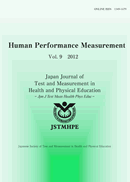The reliability and validity of any test are important. However, it is difficult to determine both the reliability and validity of tests for young children’s motor ability. Therefore, the purpose of the present study was to elucidate issues in motor ability testing in order to develop new test items for young children. First, in order to assess the “Test Characteristics” of motor ability, reliability and validity were determined by administering a motor ability test to 304 young children (boys N=159, girls N=145) aged 2-6 years. Practicality was evaluated by teachers who actually conducted the motor ability tests. Next, the following five factors were extracted using defective principal component analysis with a Normal Varimax rotation: “reliability, validity and practicality”, “practicality without familiarity of young children”, “difficult for young children and general validity”, “acceptance for young children and practicality” and “reflection of young children’s daily life, practicality and validity”. Finally, the relationship between factor scores and movement patterns, physical fitness and measurement characteristics were examined using Quantification Theory Type I. The test items related to flexibility and using the trunk had high reliably, validity and practicality; however, items related to stability did not. The test items related to power and manipulation had low practicality, but were interesting to the young children. The test items that used upper limbs and were related to coordination and stability were difficult for young children, but had high validity. Items related to agility and combination had the opposite characteristics. Test items related to the trunk, muscular endurance and manipulation were not accepted by the young children and had low practicality. Combination and using the lower limbs and trunk had high validity and practicality and reflected young children’s daily life; however, agility showed contrary findings. For the development of new items for testing the motor ability of young children, the present findings are useful because few young children’s motor ability tests satisfy all “Test Characteristics”.
View full abstract
